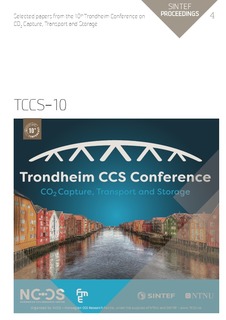| dc.contributor.author | Grøtan, Åshild | |
| dc.contributor.author | Olsen, Espen | |
| dc.contributor.author | Nygård, Heidi S. | |
| dc.date.accessioned | 2020-01-23T11:59:58Z | |
| dc.date.available | 2020-01-23T11:59:58Z | |
| dc.date.issued | 2019 | |
| dc.identifier.isbn | 978-82-536-1646-9 | |
| dc.identifier.issn | 2387-4295 | |
| dc.identifier.uri | http://hdl.handle.net/11250/2637630 | |
| dc.description.abstract | Carbon Capture in Molten Salts (CCMS) is an absorption-based method of separating CO2 from a flue gas or industrial gas through a thermal swing technique, where the sorbent is dissolved or partially dissolved in molten salts. The method takes advantage of the reversible carbonation reaction of alkaline earth metal oxides and has previously been studied with CaO as sorbent, showing excellent absorption capacity, regeneration and cyclability compared to similar methods. If the molten salt contains certain alkaline metal halides, these may react with the formed metal carbonates in an exchange reaction, shifting the equilibrium towards further carbonation. The CCMS process is however energy intensive and the regeneration of the sorbent has been identified as a main cost driver due to high operating temperatures and high reaction enthalpy. In this study, a screening of alternative chemical systems with MgO, SrO and CaO as sorbents has been performed. The aim is to find chemical systems with lower operating temperatures and reaction enthalpies that work as efficiently as in previous studies, as this could reduce energy demand and thus operational costs. Promisingly high reaction stability and conversion ratio was found with MgO-FLiNaK, but more experiments are needed to see if the absorption efficiency may be sufficiently improved. SrO-NaCl-CaCl2 showed an even higher conversion ratio, but lower reaction stability which may be improved in a different salt mixture. Furthermore, it was found that the chemical system CaO-LiF-CaF2, which has been very efficient in previous studies, seemed to have no active exchange reaction when the CaF2 was replaced by CaCl2. Another new finding is that even though studies have shown that CCMS may operate well above the solubility limit of the sorbent, the sorbent does need to have a certain solubility in the melt in order to absorb any CO2. | |
| dc.language.iso | eng | |
| dc.publisher | SINTEF Academic Press | |
| dc.relation.ispartof | Proceedings of the 10th Trondheim Conference on CO2 Capture, Transport and Storage ; TCCS-10, 2019 | |
| dc.relation.ispartofseries | SINTEF Proceedings;4 | |
| dc.rights | CC BY NC ND | |
| dc.rights.uri | http://creativecommons.org/licenses/by-nc-nd/4.0/ | |
| dc.subject | Carbon Capture in Molten Salts ; CCMS | |
| dc.subject | Carbonate Looping | |
| dc.subject | Metal Oxides as CO2 sorbents | |
| dc.title | Carbon Capture with Metal Oxides in Molten Salts: MgO, SrO and CaO AS Sorbents | |
| dc.type | Chapter | |
| dc.type | Conference object | |
| dc.type | Peer reviewed | |
| dc.description.version | publishedVersion | |
| dc.rights.holder | © 2021 The Authors. Published by SINTEF Academic Press. | |
| dc.subject.nsi | VDP::Teknologi: 500 | |
| dc.source.pagenumber | 21-27 | |

